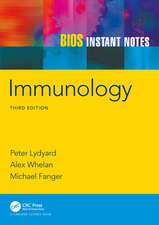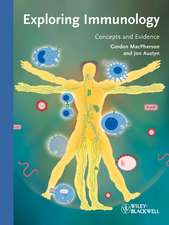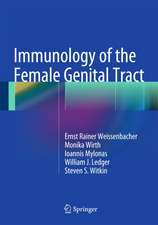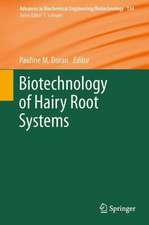Immunology of Fungal Infections
Editat de Gordon D. Brown, Mihai G. Neteaen Limba Engleză Hardback – 2 apr 2007
| Toate formatele și edițiile | Preț | Express |
|---|---|---|
| Paperback (1) | 1610.67 lei 6-8 săpt. | |
| SPRINGER NETHERLANDS – 10 noi 2010 | 1610.67 lei 6-8 săpt. | |
| Hardback (1) | 1526.16 lei 38-44 zile | |
| SPRINGER NETHERLANDS – 2 apr 2007 | 1526.16 lei 38-44 zile |
Preț: 1526.16 lei
Preț vechi: 1606.49 lei
-5% Nou
Puncte Express: 2289
Preț estimativ în valută:
292.12€ • 317.42$ • 245.54£
292.12€ • 317.42$ • 245.54£
Carte tipărită la comandă
Livrare economică 17-23 aprilie
Preluare comenzi: 021 569.72.76
Specificații
ISBN-13: 9781402054914
ISBN-10: 1402054912
Pagini: 512
Ilustrații: XVIII, 492 p.
Dimensiuni: 155 x 235 x 27 mm
Greutate: 0.98 kg
Ediția:2007
Editura: SPRINGER NETHERLANDS
Colecția Springer
Locul publicării:Dordrecht, Netherlands
ISBN-10: 1402054912
Pagini: 512
Ilustrații: XVIII, 492 p.
Dimensiuni: 155 x 235 x 27 mm
Greutate: 0.98 kg
Ediția:2007
Editura: SPRINGER NETHERLANDS
Colecția Springer
Locul publicării:Dordrecht, Netherlands
Public țintă
Professional/practitionerCuprins
Preface
Section 1: Cells
chapter 1: Macrophages
Sigrid E.M. Heinsbroek and Siamon Gordon; University of Oxford
chapter 2: Dendritic cells
Luigina Romani; University of Perugia
chapter 3: The neutrophil
David H. Dockrell, Emmet E. McGrath, Moira KB Whyte, and Ian Sabroe; University of Sheffield
chapter 4: Lymphocytes
Anna Vecchiarelli, Antonella Mencacci, Francesco Bistoni ; University of Perugia
chapter 5: Other cells: The role of non-neutrophilic granulocytes, NK and NKT cells in fungal immunology
Jeremy CD Wiseman and Christopher H. Mody; University of Calgary
chapter 6: Genes and gene pathways in Candida Infection
Robert B. Ashman, Camile S. Fara, and Christine Wells; University of Queensland and Griffith University
Section 2: Soluble factors
chapter 7: Collectins and pentraxins
Uday Kishore and Ken Reid; University of Oxford and Justus-Liebig-University
chapter 8: Complement in fungal infections and complement evasion strategies
Cornelia Speth, Cornelia Lass-Flörl and Reinhard Würzner; Innsbruck Medical University and Ludwig-Boltzmann-Institute of AIDS Research.
chapter 9: Cytokines
Karen F. Buckland and Cory M. Hogaboam; University of Michigan Medical School.
chapter 10: Antibodies
Josè Lòpez-Ribot, Rosalìa Dìez-Orejas and Concha Gil ; The University of Texas at San Antonio and Complutense University
Section 3: Non-Opsonic Fungal Receptors
chapter 11: The recognition of fungal pathogens by Toll-like receptors
Mihai G. Netea, Jos WM Van der Meer, Bart Jan Kullberg; Radboud University Nijmegen Medical Center and Nijmegen University Center for Infectious Diseases
chapter 12: Fungal ß-glucans and their receptors
S Vicky Tsoni and Gordon D Brown; University of Cape Town
chapter 13: Detection of fungi by mannose-basedrecognition receptors
F Meyer-Wentrup, A Cambi, CG Figdor and GJ Adema; Radboud University Nijmegen Medical Center
Section 4: Immunity to specific pathogens
chapter 14: Pneumocystis
Laura McKinley and Chad Steele, University of Pittsburgh School of Medicine
chapter 15: Interactions of Aspergillus fumigatus with its host during invasive pulmonary infections
Jean-Paul Latgé and Anne Beauvais; Pasteur Institute
chapter 16: C. albicans and C. glabrata
Desa Lilic and Ken Haynes, School of Clinial Medicines, Newcastle University and Department of INfectious diseases, Imerpial College London
chapter 17: Immunology of infections with Cryptococcus neoformans
Pauline Ellerbroek, Anna Vecchiarelli, Andy Hoepelman and Frank Coenjaerts; University Medical Center and University of Perugia.
chapter 18: Histoplasma capsulatum
Joshua D Nosanchuk; Albert Einstein College of Medicine
Section 5
chapter 19: Escape mechanisms from the immune response
David M. Underhill; Cedars-Sinai Medical Center
Section 6: Immune-based therapeutic strategies
chapter 20: Cytokine treatment of fungal infections
Bart-Jan Kullberg; Radboud University Nijmegen Medical Center
chapter 21: Fungal vaccines and vaccination: problems and perspectives
Antonio Cassone; Istituto Superiore di Santià
Index
Section 1: Cells
chapter 1: Macrophages
Sigrid E.M. Heinsbroek and Siamon Gordon; University of Oxford
chapter 2: Dendritic cells
Luigina Romani; University of Perugia
chapter 3: The neutrophil
David H. Dockrell, Emmet E. McGrath, Moira KB Whyte, and Ian Sabroe; University of Sheffield
chapter 4: Lymphocytes
Anna Vecchiarelli, Antonella Mencacci, Francesco Bistoni ; University of Perugia
chapter 5: Other cells: The role of non-neutrophilic granulocytes, NK and NKT cells in fungal immunology
Jeremy CD Wiseman and Christopher H. Mody; University of Calgary
chapter 6: Genes and gene pathways in Candida Infection
Robert B. Ashman, Camile S. Fara, and Christine Wells; University of Queensland and Griffith University
Section 2: Soluble factors
chapter 7: Collectins and pentraxins
Uday Kishore and Ken Reid; University of Oxford and Justus-Liebig-University
chapter 8: Complement in fungal infections and complement evasion strategies
Cornelia Speth, Cornelia Lass-Flörl and Reinhard Würzner; Innsbruck Medical University and Ludwig-Boltzmann-Institute of AIDS Research.
chapter 9: Cytokines
Karen F. Buckland and Cory M. Hogaboam; University of Michigan Medical School.
chapter 10: Antibodies
Josè Lòpez-Ribot, Rosalìa Dìez-Orejas and Concha Gil ; The University of Texas at San Antonio and Complutense University
Section 3: Non-Opsonic Fungal Receptors
chapter 11: The recognition of fungal pathogens by Toll-like receptors
Mihai G. Netea, Jos WM Van der Meer, Bart Jan Kullberg; Radboud University Nijmegen Medical Center and Nijmegen University Center for Infectious Diseases
chapter 12: Fungal ß-glucans and their receptors
S Vicky Tsoni and Gordon D Brown; University of Cape Town
chapter 13: Detection of fungi by mannose-basedrecognition receptors
F Meyer-Wentrup, A Cambi, CG Figdor and GJ Adema; Radboud University Nijmegen Medical Center
Section 4: Immunity to specific pathogens
chapter 14: Pneumocystis
Laura McKinley and Chad Steele, University of Pittsburgh School of Medicine
chapter 15: Interactions of Aspergillus fumigatus with its host during invasive pulmonary infections
Jean-Paul Latgé and Anne Beauvais; Pasteur Institute
chapter 16: C. albicans and C. glabrata
Desa Lilic and Ken Haynes, School of Clinial Medicines, Newcastle University and Department of INfectious diseases, Imerpial College London
chapter 17: Immunology of infections with Cryptococcus neoformans
Pauline Ellerbroek, Anna Vecchiarelli, Andy Hoepelman and Frank Coenjaerts; University Medical Center and University of Perugia.
chapter 18: Histoplasma capsulatum
Joshua D Nosanchuk; Albert Einstein College of Medicine
Section 5
chapter 19: Escape mechanisms from the immune response
David M. Underhill; Cedars-Sinai Medical Center
Section 6: Immune-based therapeutic strategies
chapter 20: Cytokine treatment of fungal infections
Bart-Jan Kullberg; Radboud University Nijmegen Medical Center
chapter 21: Fungal vaccines and vaccination: problems and perspectives
Antonio Cassone; Istituto Superiore di Santià
Index
Caracteristici
A definitive text covering all aspects of the immunology of fungal infections Chapters written by leading experts in the field Detailed coverage of each component of immunity and their relation to fungal infection Specific attention to the immunology of selected fungal pathogens









